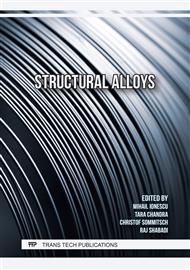p.121
p.129
p.137
p.143
p.149
p.157
p.163
p.169
p.177
Defects-Driven Plasticity: Rationalization Based on Notch Strengthening and Continuous Damage Mechanics
Abstract:
A novel procedure for material quality assessment developed for castings like ductile irons and Al alloys, is based on the analysis of tensile strain hardening through dislocation-density-related constitutive equation, and consists of plotting the Voce equation parameters found through modeling the tensile flow curves with the Voce constitutive equation. In sound materials the Voce parameters have a regular trend, consistent with the physical meaning of the dislocation-density-related Voce constitutive equation. The Voce parameters identify a regular trend also in defective materials, even if defects and metallurgical discontinuities might be expected to add a random and unpredictable component to the plastic behavior. This unexpected regular behavior in defective materials has been called as Defects-Driven Plasticity (DDP), and its rationalization seems to be possible by coupling the concepts of Notch Strengthening (NS) of defects, and stable ductile fracture propagation of the Continuous Damage Mechanics (CDM). The rationalization of DDP and the experimental findings to support, are here reported in high Silicon strengthened ductile irons.
Info:
Periodical:
Pages:
169-175
Citation:
Online since:
December 2023
Authors:
Price:
Сopyright:
© 2023 Trans Tech Publications Ltd. All Rights Reserved
Share:
Citation:



